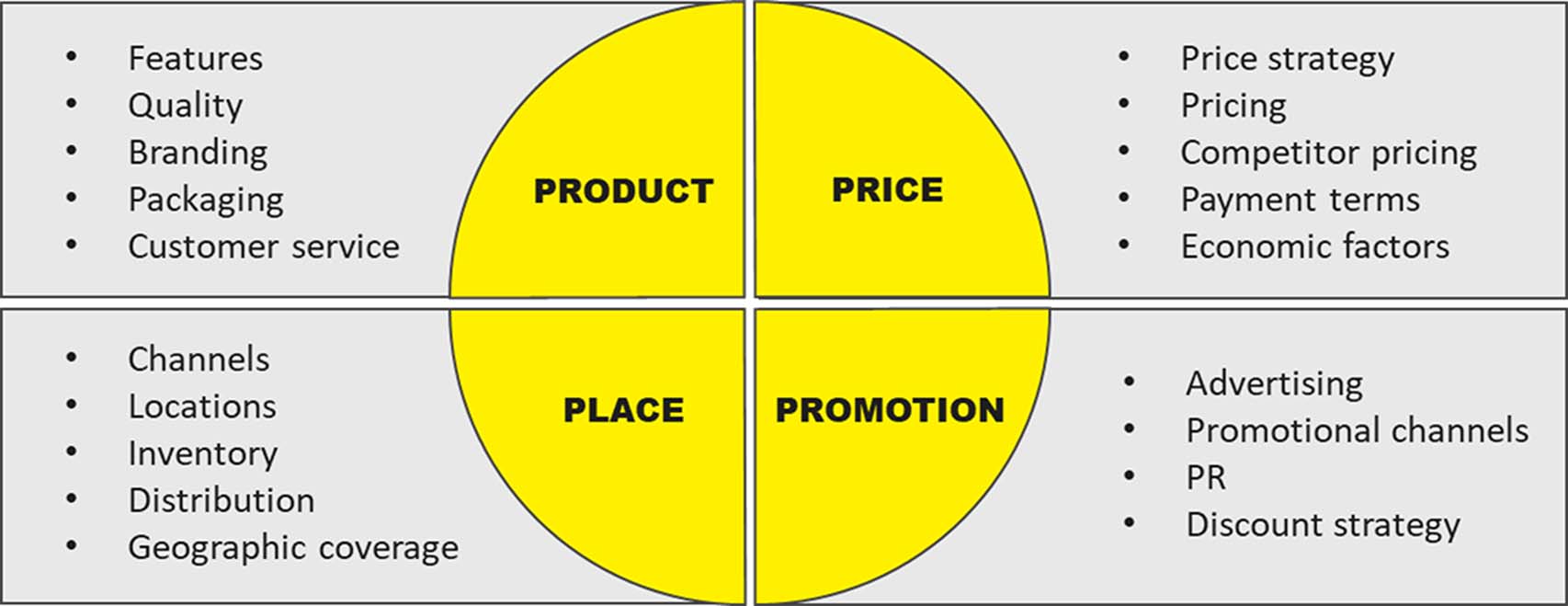

4Ps Model
4Ps Model
What is The 4Ps Model in Marketing?
Lorem ipsum dolor sit amet, consectetur adipiscing elit. Suspendisse varius enim in eros elementum tristique. Duis cursus, mi quis viverra ornare, eros dolor interdum nulla, ut commodo diam libero vitae erat. Aenean faucibus nibh et justo cursus id rutrum lorem imperdiet. Nunc ut sem vitae risus tristique posuere.
Introduction: Why the 4Ps Still Matter
More than sixty years after its creation, the 4Ps Model remains one of the most enduring concepts in marketing. First introduced in the 1960s, it provided businesses with a simple yet powerful way to organise and evaluate the levers that influence customer demand: Product, Price, Place, and Promotion. While today’s marketing landscape is vastly more complex — shaped by digital ecosystems, shifting customer expectations, and rapid innovation — the 4Ps continue to underpin how organisations think about positioning, value, and go-to-market execution.
The reason for its longevity is straightforward. The 4Ps collect the essential questions every organisation must answer when bringing an offering to market: What are we selling? How should it be priced? Where will customers access it? How will they hear about it? For business leaders navigating diverse channels, global customers, and constant competitive pressure, these questions remain foundational.
Yet the relevance of the 4Ps is not simply historical. In 2025, the model still plays a critical role in structuring strategic thinking. It offers a disciplined way to evaluate go-to-market choices, align commercial priorities, and link marketing decisions to financial outcomes. Whether a scaling technology firm clarifying its proposition or an established organisation reshaping its product portfolio, the 4Ps provide a grounding framework that supports focus and coherence.
Importantly, the model has also evolved. The shift towards services, personalisation, and customer experience has expanded the classic 4Ps to include People, Process, and Physical Evidence — now commonly referred to as the 7Ps. Similarly, newer frameworks such as the 4Cs (Customer, Cost, Convenience, Communication) reframe the model from the buyer’s perspective. These extensions do not replace the 4Ps; rather, they acknowledge that modern marketing environments require a broader lens.
Still, the original 4Ps retain their strategic significance. They offer a shared language across the organisation — from marketing to finance, operations, and the board — helping leadership teams prioritise investment, assess trade-offs, and ensure decisions remain connected to customer and commercial realities. When combined with contemporary tools and data, the 4Ps become an adaptable framework for understanding how value is created and delivered.
Ultimately, the 4Ps endure because they encourage disciplined thinking. In a market saturated with complexity, that discipline matters more than ever. As businesses continue to respond to pressures of growth, competition, and digitisation, the 4Ps provide clarity — anchoring strategy in the fundamental drivers of customer choice.

What Is the 4Ps Model?
The 4Ps Model — more commonly known as the marketing mix — is a strategic framework used to define and manage the key variables organisations can influence to stimulate demand and deliver value. The four components are Product, Price, Place and Promotion. Together, they articulate how a business shapes its offering, presents it to the market, and persuades customers to engage.
The model was formalised in the early 1960s by E. Jerome McCarthy, a leading professor of marketing. While marketing theory had existed for decades, McCarthy’s contribution was the simplification of commercial decision-making into four controllable levers. This clarity was transformative. It enabled leaders to move beyond fragmented tactics and view marketing as an integrated system capable of driving measurable business outcomes.
The 4Ps gained further prominence through Philip Kotler, who adopted the framework in his foundational marketing texts. As global organisations matured, the model became deeply embedded in both academic teaching and corporate practice. For generations of marketers, it served as the principal organising mechanism for designing, planning and evaluating marketing strategy.
At its core, the 4Ps are not theoretical constructs; they are practical decision domains.
- Product defines what is being offered and why it matters.
- Price signals value and competitive positioning.
- Place determines market access.
- Promotion articulates how awareness and intent are built.
Each element influences the others. A premium product needs pricing that reinforces its positioning, promotion that communicates its value, and distribution that confirms its credibility. Conversely, a mass-market product may prioritise cost efficiency, broad availability and high-reach promotional channels. The power of the framework lies in its emphasis on alignment — coherence across decisions to create a compelling, consistent customer experience.
Although originally developed in a product-led economy dominated by consumer goods, the 4Ps quickly gained traction across industries. Manufacturing, retail, services and later technology-based businesses all adopted the model as a structured approach to designing market offerings. It provided a common language for multidisciplinary teams to collaborate: marketers, sales leaders, product managers, and operational specialists could align around shared priorities and trade-offs.
Today, the 4Ps remain foundational because they still address the essential challenge of marketing: connecting what a business offers with what customers value. The model can be applied at multiple levels — from defining a new venture’s go-to-market strategy to refining the value proposition for an individual product or service line. It can also guide financial, operational and channel decisions, making it as relevant to executives and investors as it is to marketing teams.
While modern extensions such as the 7Ps build on McCarthy’s original thinking, the core purpose of the 4Ps remains constant: to ensure organisations take a structured, market-oriented approach to value creation and commercial execution. In dynamic markets characterised by rapid innovation and changing customer expectations, this foundational discipline continues to provide clarity in decision-making.
Understanding Each “P” in the Marketing Mix
The strength of the 4Ps lies not only in their simplicity but in how they interact to create a market competitive advantage. Each element represents a strategic lever that shapes how customers perceive value and how effectively an organisation can deliver on its commercial ambitions.
Product — Defining What You Offer
The Product element refers to the tangible goods, services, or solutions an organisation brings to market. It encompasses not only core functionality but also the features, design, branding, and experience that together create customer value. Increasingly, “product” extends beyond physical attributes to include digital experiences, service models, and data-enabled enhancements.
At its core, the product should solve a meaningful problem or satisfy a recognised need. Whether the offering is a consumer packaged good, a SaaS platform, or a professional service, clarity of purpose drives differentiation. Strategic decision-making at this stage involves determining which customer segments to serve, what attributes matter most to them, and how the product can outperform alternatives in ways competitors cannot easily replicate.
Modern product decisions also account for lifecycle dynamics — from development and introduction through to growth, maturity, and retirement. This lifecycle perspective enables organisations to anticipate shifts in customer demand, adjust investment profiles, and manage portfolio priorities. In many sectors, innovation cycles have shortened dramatically; the ability to evolve features, services, and supporting experiences is now central to sustaining competitive relevance.
Branding remains integral to the product dimension. A compelling brand identity — supported by consistent messaging and experience — can influence perceived quality and justify premium pricing. In high-consideration B2B categories, thought leadership, implementation support, and post-purchase service also form part of the “product”, reinforcing value beyond the core offering.
Ultimately, product strategy answers a decisive question: Why will customers choose this offering instead of another?
Price — Signalling Value and Positioning
Price represents the financial cost customers are willing to pay for an offering, but its strategic significance extends well beyond revenue generation. Pricing signals value, differentiates positioning, and influences how customers perceive quality and performance. It is therefore one of the most powerful levers within the marketing mix.
Pricing decisions consider production costs, customer demand, competitive dynamics, and brand positioning. For premium brands, higher pricing can reinforce exclusivity and perceived value; for cost disruptors, aggressive pricing may communicate accessibility or challenge incumbents. The optimal approach balances margin objectives with market expectations, recognising that customers rarely evaluate price in isolation — they judge it relative to perceived benefit.
A range of tactical models can support pricing strategy:
- Value-based pricing
- Tiered or subscription pricing
- Freemium entry models
- Bundling and unbundling
- Dynamic or usage-based pricing
These mechanisms allow organisations to align pricing to behaviour, encouraging customer adoption while maximising lifetime value. In B2B environments, pricing strategy often incorporates negotiation, performance-based elements, or long-term contracting to reflect complexity and relationship dynamics.
Price also plays a critical role during product launch and market entry. Early pricing decisions influence competitive response and shape customer expectations that can persist for years. As markets evolve, continued refinement is essential — misalignment between price and perceived value can erode profitability or slow adoption.
Ultimately, pricing strategy is both a commercial and psychological exercise. It requires balancing analytical rigour with a deep understanding of how customers perceive value.

"The 4Ps Model is a fundamental framework. While effective, it requires adaptation for customer-centricity, broader environmental factors, differentiation, and the complexities of today's market."
Paul Mills - Chartered Fractional CMO & Founder, VCMO
Place — Access and Distribution
Place refers to the channels, platforms, and environments through which an offering is made available to customers. Historically associated with physical retail and distribution logistics, the concept has expanded dramatically in the digital era to include e-commerce platforms, online marketplaces, partner networks, and direct-to-consumer ecosystems.
Effective place strategy ensures that customers can access products where, when, and how they prefer to purchase. For some businesses, this involves prioritising direct channels that enable greater control over brand and customer experience. Others may rely on distribution partners or marketplaces to expand reach, enter new geographies, or accelerate time-to-market.
Every choice creates trade-offs. Direct channels offer higher margins and richer customer insight but require investment in fulfilment, service, and marketing. Indirect channels provide scale and access but may dilute brand control or margin. Hybrid models — blending owned and partnered channels — have become common as organisations seek both control and reach.
In B2B industries, channel strategy may involve distributors, value-added resellers, consultants, or system integrators. In consumer markets, omnichannel models that integrate online and physical experiences have become the norm. Convenience, consistency, and service capability now influence buying behaviour as much as product features themselves.
Place strategy also extends to operational decisions: stockholding, lead times, logistics partnerships, and returns handling all influence customer experience. In service categories, “place” often focuses on accessibility and delivery formats — whether in-person, virtual, or hybrid.
Ultimately, place strategy is about removing friction. The objective is simple: ensure customers can purchase easily, reliably, and in the environment they prefer.
Promotion — Creating Demand and Preference
Promotion represents the communication activities an organisation uses to build awareness, shape perceptions, and drive purchase consideration. While often associated with advertising, promotion encompasses a broad set of tools that collectively influence how customers engage with a brand.
Traditional components include advertising, public relations, sales promotion, and personal selling. Today, digital channels — content marketing, search, social platforms, email, marketing automation, and influencer partnerships — are central to execution. Effective promotional strategy blends these disciplines to deliver the right message to the right audience at the right time.
The choice of channels is driven by audience behaviour, buying journey complexity, and budget considerations. High-involvement categories such as enterprise software require educational content and consultative selling, while fast-moving consumer goods may prioritise reach and frequency through paid media.
The narrative itself is critical. Compelling messaging articulates the problem, the offering’s value, and why it is preferable to alternatives. It should reinforce positioning and remain consistent across touchpoints. Increasingly, organisations use insight-led content and storytelling to differentiate, particularly in crowded markets.
Measurement underpins effective promotion. Digital platforms provide granular insight into engagement, conversion, and lifetime value, enabling continuous optimisation. Attribution models — while imperfect — help organisations understand which activities drive commercial outcomes, informing resource allocation.
Ultimately, promotion strategy shapes demand. By building salience, trust, and preference, it helps transform awareness into measurable business performance.

Strategic Value of the 4Ps
The enduring relevance of the 4Ps lies in their ability to translate organisational ambition into structured, commercially coherent decisions. Rather than functioning as a tactical checklist, the model provides an integrated framework that encourages businesses to think holistically about how offerings create value, how customers will perceive that value, and what interventions are required to convert interest into demand.
For leaders building or evolving a go-to-market strategy, the 4Ps help impose discipline at moments where complexity can otherwise dilute clarity. By breaking decisions into four controllable variables — what to offer, how to price it, where to distribute it, and how to communicate it — the model ensures that commercial strategy is grounded in market realities and customer outcomes. This is particularly useful for organisations navigating rapid growth, shifting customer needs, or increased competition.
The 4Ps also create a shared language across functions. Product teams, marketers, finance, commercial operations and the board can engage in strategy using the same conceptual framework, making trade-offs easier to discuss and decisions easier to evaluate. For example, a decision to reposition a product may require price adjustments, new distribution channels and a refreshed promotional strategy. The 4Ps provide a structured way to coordinate these interdependencies so the result feels cohesive to the customer and commercially viable to the business.
Critically, the model forces alignment between customer value and business objectives. Poorly integrated marketing strategies often fail not because of weak execution, but because decisions across product, pricing, distribution and communication are misaligned. A product may be priced as premium but promoted in a way that signals value or distributed through channels associated with low-cost brands. The 4Ps can act as a diagnostic tool to uncover these tensions early, enabling course correction before commercial performance is compromised.
In the modern planning environment, the 4Ps also sit comfortably alongside more advanced frameworks. Data-driven organisations can use analytics to inform pricing, optimise promotional investment, or tailor product variations to segment needs — all within the structure the 4Ps offer. Similarly, strategy teams can pair the 4Ps with Segmentation-Targeting-Positioning (STP) or customer journey mapping to ensure decisions reflect both internal capability and external expectation.
Ultimately, the strategic value of the 4Ps lies in their ability to organise decision-making around the few variables that most powerfully influence customer choice. When applied thoughtfully, the framework supports organisations in building differentiated propositions, aligning internal functions and designing coherent customer experiences — all of which contribute to sustainable commercial performance.

“The 4Ps remain a strategic anchor for marketing teams because they force leaders to align proposition, pricing, access, and communication before execution. When applied rigorously, they ensure commercial clarity and prevent organisations from defaulting to fragmented, channel-first activity.”
Rachael Wheatley— Chartered Fractional CMO, VCMO
Advantages of the 4Ps Framework
The 4Ps remain widely used because they provide leaders with a structured, repeatable way to understand how value is created and delivered. In environments where resources are finite and growth expectations are high, this clarity is especially valuable. The framework supports disciplined decision-making, improves cross-functional alignment, and helps organisations evaluate how their commercial choices interact to shape customer behaviour and business performance.
1) Holistic View of the Market Offering
The 4Ps compel leaders to consider the full spectrum of commercial variables — what is being offered, how it is priced, where it is accessed and how it is communicated. This breadth reduces the risk of over-emphasising one dimension, such as promotion, while neglecting product or pricing fundamentals. The model helps ensure that the entire proposition is coherent, competitive and anchored in customer value.
2) Improved Cross-Functional Alignment
Because the 4Ps provide a shared language, they enable product, marketing, finance, sales and operations to collaborate more effectively. Each team understands how its decisions affect the others, making trade-offs more transparent. This is particularly important in matrix organisations, where multiple stakeholders shape the go-to-market plan and alignment can materially influence revenue performance and time-to-market.
3) Integration and Strategic Coherence
The framework encourages leaders to design propositions where product, pricing, channel and messaging work together. This coherence builds credibility and reduces customer confusion. For example, a premium product supported by high-touch distribution and sophisticated promotion creates more perceived value than one supported by generic messaging or discount channels. The 4Ps therefore help ensure that decisions reinforce, rather than undermine, the intended positioning.
4) Customer-Centric Orientation
By asking organisations to define what customers will buy, how they will evaluate value and where they will engage, the 4Ps implicitly reinforce a customer-centred perspective. This helps ensure product and commercial decisions are grounded in real customer needs and behaviours rather than internal assumptions. The model can also guide research priorities, such as uncovering unmet needs or price sensitivity.
5) Supports Structured Strategic Planning
The 4Ps provide a disciplined framework for evaluating options and prioritising investments. Whether launching a new product or repositioning an existing one, the model helps clarify where to focus resources and where potential risks lie. This systematic approach enables leaders to test alternative scenarios before execution, improving the probability of commercial success and reducing operational waste.
6) Versatile Across Sectors and Growth Stages
Although conceived in a consumer goods context, the 4Ps have proven adaptable across industries — from SaaS and healthcare to financial services and industrial manufacturing. Equally, the model remains useful across the growth journey: start-ups can use it to define their proposition; scale-ups can use it to evaluate pricing or channel expansion; mature firms can use it to refine portfolios.
7) Accelerates Decision-Making and Trade-Off Evaluation
Go-to-market decisions often involve complex trade-offs — for example price versus volume, reach versus margin, or product depth versus simplicity. The 4Ps provide a structured mechanism for evaluating these choices by making the consequences more visible. This clarity supports faster, more confident decisions and ensures organisational energy is directed toward commercially meaningful levers.
8) Foundation for Commercial Performance Measurement
The model can help organisations translate marketing choices into measurable outcomes. Clear product definitions inform feature adoption metrics; pricing informs revenue performance; placement decisions inform channel productivity; and promotion influences awareness and conversion. Leaders can map KPIs to each dimension, building accountability and enabling data-driven optimisation.
9) Effective Resource Allocation
Because the 4Ps break decisions into defined areas, they make it easier to allocate budget and capability where it will have the greatest impact. Leaders can compare investment across different levers, ensuring that spending is proportional to commercial opportunity. This is especially valuable for businesses operating under financial constraints or seeking greater ROI transparency.
10) Supports Competitive Differentiation
The 4Ps encourage organisations to examine how each element can strengthen their competitive position. Product features, pricing model, distribution reach and promotional narrative all have the potential to differentiate. Used together, they guide the development of value propositions that stand apart and are harder for competitors to replicate.

“The strength of the 4Ps lies in its simplicity. It enables cross-functional teams to frame decisions cohesively, ensuring that product, pricing, route-to-market and messaging reinforce each other. This discipline is particularly valuable when entering new markets or repositioning an established brand.”
Lydia McClelland — Chartered Fractional CMO, VCMO
Limitations of the 4Ps Framework
While the 4Ps remain foundational to modern marketing practice, they reflect a product-centred model developed in a different era. Markets have since evolved: services dominate, customer expectations are dynamic, and digital ecosystems enable new routes to value creation. As a result, the 4Ps alone can feel incomplete. Understanding its limitations enables leaders to supplement the model with other frameworks that better reflect contemporary realities.
1) Narrow Product-Centric Focus
The 4Ps emphasise the product as the centre of decision-making. In today’s markets, customer experience, service delivery, and relationship value often drive success more than product attributes alone. Customer needs, behaviours, and outcomes may therefore require more prominent consideration than the original framework accommodates.
2) Limited Relevance for Services
The framework was developed for tangible goods rather than service-based propositions, where value is delivered through people, process and experience. As services became more dominant, additional Ps — People, Process and Physical Evidence — were added, forming the 7Ps. Without these extensions, the original model underrepresents the dynamics of service quality, customer interaction, and operational design.
3) Simplifies Pricing Dynamics
The 4Ps treat price primarily as a cost-to-value equation, understating modern pricing strategies such as subscription, pay-per-use, bundling, dynamic pricing, and value-based methods. In practice, pricing strategy is heavily influenced by behavioural economics, competitive dynamics and customer lifetime value — complexities the original model does not explicitly address.
4) Understates Customer Relationships
The model views promotion as a broad communication exercise, but modern marketing focuses heavily on relationship-building, retention, and personalised engagement. Concepts such as community, loyalty, customer success, and lifetime value sit awkwardly within the 4Ps and often require complementary frameworks to be adequately expressed and operationalised.
5) Insufficient for Digital-First Environments
Digital ecosystems have introduced new distribution and promotional channels, real-time analytics, and two-way customer interaction. While these can be mapped back to the 4Ps, the model does not inherently capture digital complexities such as multi-touch attribution, platform economics, data governance, self-serve environments, and continuous optimisation.
6) Overlooks Broader Market Forces
The 4Ps focus on internal levers within the organisation’s control but underplay external forces — regulatory change, sustainability expectations, technological disruption, cultural shifts and macroeconomics. Other frameworks, such as PESTLE, are needed to ensure that go-to-market strategy accounts for changes that sit beyond Product, Price, Place and Promotion.
7) Limited Support for Strategic Differentiation
Because the model is widely adopted, it risks leading to homogeneity: organisations may arrive at similar conclusions because they are using the same mental model. Without deeper strategic insight, competitive differentiation can become incremental rather than genuinely distinctive. Frameworks such as Blue Ocean Strategy can help organisations find more differentiated positions.
8) Weak Integration of Brand and Purpose
Brand positioning and corporate purpose significantly influence customer perception and employee alignment. These intangible drivers are central to value creation, but they are not explicitly captured within the 4Ps. Promotion covers messaging, yet brand strategy and purpose extend far beyond communication, influencing culture, innovation and customer loyalty.
9) Limited Guidance on Ecosystem Strategy
Modern businesses increasingly compete within ecosystems — collaborating with partners, platforms and marketplaces. The 4Ps assume a linear supplier-to-customer model and do not fully address networked environments, platform economics, partner enablement or shared value creation. Additional models are needed to evaluate ecosystem choices and interdependencies.
10) Static View in Dynamic Markets
The 4Ps offer a structured snapshot in time but do not inherently support continuous iteration. In dynamic environments — such as SaaS and D2C — propositions evolve rapidly based on customer feedback and data. Agile and experimentation-led methodologies are often required to complement the 4Ps with real-time adaptation and test-and-learn cycles.

“The 4Ps can fall short when viewed purely as an internal model. It underplays customer experience, service design and the role of community. Modern marketing requires moving beyond transactional thinking to consider ongoing relationships, value creation and long-term engagement.”
Ruth Napier — Chartered Fractional CMO, VCMO
The 4Ps in Today’s Market Context
Modern marketing environments are significantly more complex than those in which the 4Ps were first conceived. Digital ecosystems, data-driven decision-making, shifting customer expectations and subscription-based business models have transformed how organisations create and deliver value. Yet despite these changes, the 4Ps remain relevant — not as a complete model, but as a stable foundation upon which broader frameworks and capabilities can be constructed. Understanding how the 4Ps operate in contemporary markets helps leaders apply them more intelligently and avoid defaulting to outdated patterns of thinking.
One of the most notable shifts is the centrality of customer experience. In many sectors — from financial services to software — experience has become as important as product functionality. The “Product” dimension now includes onboarding experience, customer support, user interface, data integration and personalisation. These components influence satisfaction and loyalty as strongly as the underlying product itself. Modern organisations therefore apply a broader interpretation of Product, integrating service design, user experience and value delivery into a single proposition.
Similarly, the nature of Place has expanded well beyond physical distribution. Digital channels, virtual service delivery and platform marketplaces have redefined what access looks like. Companies must consider Amazon, app stores, third-party integrators, distributor networks and direct-to-consumer models simultaneously — often blending them to maximise reach and customer convenience. Place strategy is now inseparable from technology infrastructure, customer data management and operational flexibility.
The Price dimension has also evolved markedly. Subscription, usage-based pricing, tiered packages and value-based models dominate categories such as SaaS and healthcare, while dynamic pricing is omnipresent in travel, retail and mobility services. Price now plays a critical role in segmentation and revenue strategy; it shapes adoption curves, customer lifetime value and margin profiles. Organisations must therefore consider pricing as an iterative capability rather than a static decision.
Promotion has undergone the most visible transformation. The internet has democratised communication, shifting power from brands to buyers. Traditional campaigns have given way to integrated digital ecosystems that combine content, search, social influence, CRM, automation, and performance marketing. Promotion now demands real-time optimisation, experimentation and ongoing measurement. The challenge is no longer message delivery, but message relevance — ensuring the right narrative reaches the right audience via the right channel at a precise moment in their buying journey.
In parallel, data and technology have introduced new levels of sophistication. AI tools, customer analytics and marketing automation platforms allow organisations to segment audiences dynamically, personalise experiences and attribute outcomes with increasing granularity. These capabilities reinforce the value of the 4Ps as a structural baseline, while highlighting the need for additional models — such as the customer journey, service blueprinting or lifecycle economics — to ensure that decisions reflect behavioural reality.
The 4Ps have therefore become more interdependent. Changes to one dimension have amplified consequences across the others. Adjustments in product features may require revised pricing, new channel partnerships or refreshed messaging. Similarly, promotional activity may be constrained or enabled by channel access or product readiness. This interconnectedness increases the importance of coordinated planning that aligns commercial, operational and customer-facing teams around shared priorities.
Crucially, today’s context requires leaders to embed agility. The 4Ps impose strategic structure, but they must be complemented with test-and-learn approaches that respond to rapid shifts in technology, regulation and consumer behaviour. Experimentation — whether in pricing, product configuration or message positioning — has become integral to extracting value from the model. Organisations that treat the 4Ps as a rigid template risk missing emerging opportunities or responding too slowly to change.
In summary, while the 4Ps originated in a product-led world, they remain strategically valuable. In contemporary markets, their greatest strength lies in providing a conceptual anchor — a way to organise decisions and align organisations — while allowing the flexibility required to navigate fluid customer needs, fragmented channels and data-rich execution environments. Rather than replacing the model, modern marketing practice builds upon it, extending its scope through complementary frameworks that address experience, service delivery and customer relationships.

“In today’s market, the 4Ps still matter — but only when integrated with customer insight, digital behaviour and lifecycle thinking. The framework works best as a foundation that is enriched with data, personalisation and iterative test-and-learn methods.”
Paul Mills — Chartered Fractional CMO & Founder VCMO
How the 4Ps Have Evolved
As markets, customer expectations and business models evolved, so did the need for a broader lens on marketing strategy. While the original 4Ps offered a robust foundation for evaluating product-led propositions, they did not fully account for the complexities of service delivery, customer experience or people-driven value. In response, modern marketing practice expanded the framework to include three additional variables — People, Process and Physical Evidence — creating what is now widely known as the 7Ps.
This evolution was driven by the rise of service-based economies, where value is delivered not through discrete products alone, but through ongoing engagement. In services, the customer experience is co-created between provider and consumer; satisfaction depends on staff capability, operational design and the environment in which the service is delivered. These components directly influence perceived quality and loyalty, yet they fell outside the remit of the original 4Ps.
- People - The first addition, People, recognises the critical role employees play in shaping customer outcomes. Whether in a private healthcare setting, a professional services firm or a SaaS customer success function, the knowledge, behaviour and communication of individuals materially influence customer trust and satisfaction. People strategies, therefore, encompass recruitment, training, culture and incentivisation — all of which shape commercial performance.
- Process - The second extension, Process, reflects the systems and workflows governing how a service is delivered. Consistency, responsiveness and efficiency often define the customer experience as strongly as the underlying product. Clear processes also support scalability, helping organisations deliver high-quality outcomes across geographies, customer segments and lifecycle stages. In technology-based environments, process integration — across onboarding, support and renewal — is central to long-term value creation.
- Physical Evidence - The final addition, Physical Evidence, captures the tangible cues that signal quality and credibility in service environments. This can range from the physical setting of a law firm’s offices to the user interface of a digital platform or the documentation that accompanies an advisory engagement. These artefacts help mitigate uncertainty, particularly where outcomes are intangible or realised over time. They also enable providers to differentiate and reinforce brand positioning.
The 7Ps are especially relevant in sectors where customer experience, service delivery and relationship management play a central role. Professional services, financial services, hospitality, education and technology-led subscription models rely heavily on factors beyond the core product. The 7Ps provide a more accurate model for designing propositions that integrate service and experience alongside functional value.
Importantly, the 7Ps do not replace the original 4Ps; they extend them. Organisations can adopt the expanded model when greater sensitivity to experience and operational delivery is needed. Product-led businesses may find the original 4Ps sufficient, especially where distribution is predictable and customer relationships are transactional. However, as businesses increasingly integrate services with products — for example, SaaS firms offering implementation and support — the expanded framework becomes more useful.
The evolution of the model highlights a broader truth: marketing frameworks must adapt to reflect changing economic structures. The shift from goods to services, and now from services to integrated experience ecosystems, requires tools that can capture both tangible and intangible value. The movement from 4Ps to 7Ps therefore represents not a departure from traditional thinking, but an enhanced commitment to understanding how organisations create value in modern markets.
“The evolution of the 4Ps reflects broader shifts toward customer-centricity and service-based economies. Extensions such as the 7Ps bring people, process and experience into scope, helping marketers design propositions that feel cohesive end-to-end, not merely commercially packaged.”
Rachael Wheatley — Chartered Fractional CMO, VCMO

Comparison with Alternative Frameworks
Over time, several complementary models have emerged to address limitations within the 4Ps and to reflect the increasing importance of customer experience and strategic market segmentation. Rather than competing with the 4Ps, these frameworks broaden the lens through which organisations evaluate value creation and go-to-market choices.
4Ps vs. 4Cs
The 4Cs Model (Customer, Cost, Convenience, Communication) reframes marketing decisions from the perspective of the buyer rather than the seller.
Where the 4Ps focus on what a business provides, the 4Cs look at what customers need, how they perceive value, how easily they can access it, and how they prefer to receive information.
This creates a more outward-looking approach:
- Product → Customer needs
- Price → Cost to the customer
- Place → Convenience
- Promotion → Communication
The 4Cs are particularly useful in customer-centric strategies, where experience, friction removal and long-term relationships are central. However, many organisations apply both models together — using the 4Ps to structure internal decision-making and the 4Cs to validate that strategy through the customer lens.
4Ps vs. STP (Segmentation, Targeting, Positioning)
STP is a strategic framework that sits upstream of the 4Ps.
It requires organisations to segment their market, identify the priority audiences and define how their offering should be positioned against competitors.
Once these choices are made, the 4Ps operationalise the strategy — shaping the product, pricing, channels and promotion around the defined target.
- STP defines who to serve and how to be perceived
- The 4Ps define how that positioning is delivered to market
STP therefore strengthens the 4Ps by ensuring they are anchored in a clear strategic context.
How These Frameworks Complement One Another
Used together, STP, the 4Ps and the 4Cs provide a comprehensive commercial toolkit.
- STP identifies the most valuable market opportunities.
- 4Ps translate that strategy into tactical execution.
- 4Cs validate that choices meet customer needs and preferences.
Together, they ensure decisions are driven by market realities, operational feasibility and customer value — rather than internal assumptions alone.
Applying the 4Ps: Practical Business Examples
Understanding the 4Ps conceptually is valuable, but its real strength lies in practical application. When used thoughtfully, the framework helps leaders design market offerings that balance customer needs with commercial goals. The following examples illustrate how the 4Ps can guide decision-making across different contexts.
B2C Example — Premium Consumer Beverage Brand
A growing beverage company enters the market with an all-natural sparkling drink positioned as a healthier alternative to mainstream carbonated soft drinks.
Product: The product emphasises natural ingredients, low sugar content and distinctive flavour blends. Packaging reinforces the premium positioning through minimalist design and recyclable materials.
Price: Premium pricing communicates quality and reflects higher production costs. Small trial formats allow cautious customers to sample at a lower entry cost, while multipacks encourage volume purchase.
Place: Distribution prioritises health-led and lifestyle channels — boutique food retailers, cafés, and health stores — before expanding into major grocery chains. A selective approach maintains brand equity while enabling steady market penetration.
Promotion: Story-led campaigns focus on authenticity, sustainability and ingredient quality. Influencer partnerships and in-store sampling raise awareness, while targeted social campaigns drive trial among health-conscious consumers.
In combination, these choices build credibility, reinforce positioning and create a coherent experience that justifies a higher price point.
B2B Example — SaaS Workflow Automation Platform
A SaaS start-up providing workflow automation tools aims to sell primarily to mid-market financial services firms addressing legacy system inefficiencies.
Product: The core platform offers configurable modules, with optional implementation and training services. Key differentiators include data-security features, integrations with existing systems and role-based reporting.
Price: Pricing follows a tiered subscription model aligned to usage. Enterprise clients benefit from volume-based discounts and multi-year contracting options to improve predictability for both parties.
Place: Sales are delivered through a hybrid model: direct sales for enterprise accounts, supported by referral partners and system integrators for smaller implementations. Self-serve trials allow prospects to validate fit early.
Promotion: Marketing activity focuses on problem education rather than platform features. Content-driven thought leadership, webinars and case studies articulate business outcomes — improved efficiency, reduced processing times and regulatory compliance. Targeted account-based marketing (ABM) strengthens engagement with priority segments.
Here, the 4Ps align around a value-led narrative — reducing operational complexity and improving productivity — enabling the business to enter a regulated market with credibility.

Common Mistakes When Using the 4Ps
The 4Ps are often misunderstood or applied superficially. When used as a checklist rather than a strategic discipline, they can reinforce poor decisions, dilute positioning, or misdirect investment. By recognising common pitfalls, organisations can apply the framework with greater precision and extract more commercial value from their go-to-market strategies.
1) Treating the 4Ps as a Promotion-Only Model
A frequent mistake is equating marketing solely with promotion. This results in teams overinvesting in campaigns while neglecting foundational work on proposition, pricing or distribution. Without alignment across all four dimensions, promotional activity struggles to gain traction; messaging becomes disconnected from customer value, and increased spend delivers diminishing returns.
2) Applying the 4Ps Without Customer Insight
Organisations sometimes build product and pricing decisions on internal assumptions rather than evidence. Without customer research — such as needs analysis, price sensitivity or channel preference — the 4Ps risk reinforcing flawed strategy. The result is often well-constructed offerings that fail to resonate or convert. Customer insight is the anchor that gives the framework relevance.
3) Weak Integration Across the Four Elements
The 4Ps work best when decisions reinforce one another. Misalignment — for example, premium pricing paired with low-touch channels or undifferentiated messaging — creates friction and reduces credibility. Customers expect consistency between how a product is positioned and how it is priced, sold and communicated. Without integration, the commercial narrative breaks down.
4) Using the 4Ps as a Static Exercise
Some organisations treat the 4Ps as a one-off planning activity. In reality, markets evolve rapidly; customer behaviour, channel economics and competitive intensity all shift. Without regular reassessment, propositions become outdated and commercial performance declines. The 4Ps should be revisited at key inflection points — new product iterations, pricing reviews, channel changes or competitive moves.
5) Lack of Strategic Context (No STP Foundation)
When the 4Ps are applied without segmentation, targeting and positioning (STP), decisions lack strategic direction. Teams make product, pricing and channel choices before defining who they serve or how they intend to win. This leads to generic propositions and ineffective messaging. STP provides the strategic “why”; the 4Ps deliver the operational “how”.
6) Over-Standardising the Model
Businesses sometimes apply the 4Ps uniformly across all categories, markets or segments. In practice, the weighting of each “P” differs by context. In SaaS, pricing and onboarding may be decisive; in hospitality, experience and people matter more. Failing to adapt the model to context leads to mis-prioritisation and poor resource allocation.
7) Overlooking Operational Readiness
Promotion and pricing decisions often assume operational capability is already in place — reliable fulfilment, customer service, or channel partner support. When operational gaps exist, distribution breaks down and promotional promises cannot be fulfilled. The 4Ps require cross-functional alignment; otherwise, customer experience suffers and commercial traction is limited.
8) Underestimating the Role of Data and Experimentation
Some organisations apply the 4Ps rigidly, without room for testing. Modern marketing demands iterative optimisation — experimenting with pricing tiers, channel tactics or messaging. Treating the 4Ps as static removes agility, slowing response to market signals and making growth harder. The most successful organisations pair the 4Ps with continuous learning.
9) Over-simplifying Pricing Strategy
Leaders sometimes treat pricing as a cost-plus exercise rather than a strategic lever. Without considering willingness to pay, lifetime value, competitive dynamics or psychological price anchors, pricing fails to support positioning or growth. Because pricing influences all other “Ps,” oversimplification can undermine the entire proposition.
10) Focusing on Internal Logic, Not Customer Perception
The 4Ps can drive internal alignment, but if decisions reflect internal preferences rather than customer reality, commercial relevance declines. Customers judge coherence based on their experience — not organisational logic. Misreading customer expectations on value, delivery or communication often leads to weak traction and wasted effort.
“A common mistake is treating the 4Ps as a checklist rather than an integrated system. Teams often fixate on promotion and neglect product clarity, pricing logic or channel alignment — resulting in inconsistent propositions that fail to resonate commercially.”
Lydia McClelland — Chartered Fractional CMO, VCMO

How Business Leaders Can Use the 4Ps Today
For modern organisations, the 4Ps remain most powerful when used as a flexible strategic discipline rather than a rigid template. Business leaders can deploy the framework to clarify strategic choices, align cross-functional teams and connect commercial ambition with customer reality. In an environment characterised by rapid market shifts, the 4Ps help simplify complexity and focus leadership attention on the variables most likely to influence demand and growth.
1) Lens for diagnosis
The starting point is to use the 4Ps as a lens for diagnosis. Whether a business is entering a new market, refining an existing proposition or recalibrating its commercial model, the 4Ps can help identify where performance frictions arise. Leaders can quickly assess whether lack of traction is linked to product–market fit, pricing misalignment, channel constraints or weak promotional execution. This diagnostic orientation ensures that interventions target the most material leverage points, rather than symptoms of deeper strategic issues.
2) Scenario Planning & Portfolio Prioritisation
The framework is equally useful in scenario planning and portfolio prioritisation. By mapping multiple versions of product, pricing, distribution and promotional configurations, leadership teams can compare commercial trade-offs before deploying capital. For example, a business might explore whether modest product innovation paired with premium pricing delivers greater value than a mass-market approach supported by channel expansion and promotional intensity. This structured decision-making helps prevent strategy from being driven by instinct alone.
3) Cross Functional Alignment
The 4Ps also strengthen cross-functional alignment. Because product, pricing, channel and messaging decisions span marketing, product development, sales, finance and operations, the framework provides shared language that accelerates collaboration. For scaling organisations — where organisational design evolves faster than capability — this common vocabulary helps teams prioritise and coordinate activity. Leaders can use the 4Ps to shape quarterly planning, facilitate commercial workshops or align GTM functions around shared objectives.
4) Evidence-based Iteration
Importantly, the model supports evidence-based iteration. Organisations that embed the 4Ps into their operating rhythm can assess impact continuously — reviewing pricing elasticity, channel performance or messaging resonance — and adjust confidently. Combining the 4Ps with data sources such as customer interviews, CRM analytics, experimentation platforms and market insight enables ongoing optimisation. This iterative approach prevents stagnation and keeps propositions aligned with evolving customer expectations.
5) Pair with Other Frameworks
The 4Ps’ value is amplified when paired with upstream strategic frameworks. Segmentation, targeting and positioning (STP) provide foundational clarity on who the business is serving and how it intends to differentiate. Once those choices are made, the 4Ps translate direction into reality. Similarly, customer journey mapping and service blueprinting help ensure product, channel and communication decisions reflect behavioural insight rather than internal assumptions.
6) Resource Allocation
Many leadership teams use the 4Ps to support resource allocation and investment governance. By reviewing each component of the marketing mix, executives can identify where incremental investment is most likely to yield commercial returns. For instance, a business with a strong product and channel model but low brand awareness may focus investment on promotion; another struggling with price–value perceptions may prioritise pricing redesign or packaging innovation. This disciplined prioritisation is particularly valuable in budget-constrained environments.
7) Customer Value
Finally, the 4Ps help reinforce a customer-value mindset. When used effectively, the framework prompts strategic questions: Does our product solve a meaningful problem? Does our pricing reflect perceived value? Are we available where customers expect to buy? Does our communication reinforce brand and motivate behaviour? These questions do not replace customer research, but they create a structured approach to understanding value from the customer’s perspective.
In practice, business leaders often derive the greatest benefit by using the 4Ps as a living framework — revisiting it at key moments: product launches, market expansion, pricing reviews, rebranding efforts and performance diagnostics. This keeps commercial decision-making focused, integrated and adaptable, supporting both near-term execution and long-term growth.
Summary
More than six decades after its introduction, the 4Ps Model remains one of the most enduring and useful tools in marketing. Its strength lies in its structured simplicity: Product, Price, Place and Promotion provide a clear way to organise commercial decision-making and ensure that organisations bring compelling, coherent propositions to market. Whether used to define a new venture’s go-to-market approach, reposition an existing portfolio, or diagnose performance challenges, the framework helps leaders understand where value is created and how customer behaviour can be shaped.
The model’s longevity is explained by its adaptability. While conceived in a product-centric, goods-led economy, the 4Ps have continued to hold relevance as markets shifted towards services, experience-led delivery and digital ecosystems. Extensions such as the 7Ps, and complementary frameworks including STP and the 4Cs, build on the model rather than replace it — broadening its scope to reflect customer experience, service design, and strategic targeting. Together, these tools help organisations blend internal trade-off decisions with external market insight.
At the same time, it is important to recognise the framework’s limitations. As markets have become more dynamic, the risk of treating the 4Ps as a static checklist has increased. Used in isolation, the model may overlook relationship value, behavioural economics, data-driven iteration or ecosystem strategy. Business leaders therefore benefit most when they apply the 4Ps as a flexible foundation — supplementing it with customer insight, cross-functional alignment, and iterative testing to refine propositions and improve commercial outcomes.
Ultimately, the 4Ps endure because they remain a powerful anchor in environments characterised by complexity and rapid change. By encouraging disciplined thinking and shared language, they help teams design propositions that resonate with customers, align with strategic goals, and drive measurable growth. In 2025 and beyond — as organisations balance innovation with execution and customer demands with commercial constraints — the 4Ps will continue to serve as a practical guide for bridging strategy and action in pursuit of sustainable performance.
About VCMO
VCMO is a UK-based provider of fractional marketing services, supporting B2B SMEs—ranging from funded scale-ups to mid-tier and private equity-backed businesses—through key moments of growth and transformation. Its Chartered Fractional CMOs and SOSTAC® certified planners embed strategic marketing leadership into organisations navigating product launches, new market entry, acquisitions, and leadership gaps.
Ready to take your marketing to the next level? Let us help you get there.
Subscribe to Our Newsletter
Fractional Edge is our montly newsletter sharing expert opinion on the latest trends in fractional leadership, curated marketing content from leading sources, VCMO events, and much more. Subscribing is quick — just add your name and email.









